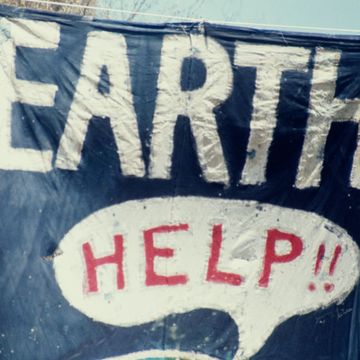As winter storms were buffeting parts of the country last week, our collective attention was drawn halfway around the world to Egypt. Images of the pyramids and the Sphinx covered in snow had emerged, and were being shared tens of thousands of times on Facebook and Twitter. It wasn't hard to see why. For some, sharing the photos was a statement on global warming. For others, sharing was about the triumph of discovery, making them proud housecats dropping a half-chewed mouse of news on the Internet's doorstep. For most, however, the photos were just another thoughtlessly processed and soon-forgotten item that represented our now-instinctual response to the unrelenting stream of information we're subjected to every waking hour: Share first, ask questions later. Better yet: Let someone else ask the questions. Better still: What was the question again?
Needless to say, the photos were bullshit.
It's hard not to note the tidy symbolism here. The Internet, like the Sphinx, is a ravenous beast that eats alive anyone who can't answer its hoary riddle. We in the media have been struggling for twenty years to solve that riddle, and this year, the answer arrived: Big Viral, a Lovecraftian nightmare that has tightened its thousand-tentacled grip on our browsing habits with its traffic-at-all-costs mentality—veracity, newsworthiness, and relevance be damned. We solved the riddle, and then we got eaten anyway.
BuzzFeed's Jonah Peretti admitted as much when explaining, that, when he's hiring, he looks for "people who really understand how information is shared on Twitter and Facebook and Instagram and other emerging platforms, because that is in some cases as important as, you know, having traditional reporting talent." Upworthy editorial director Sara Critchfield seconded the notion. "We reject the idea that the media elite or people who have been trained in a certain way somehow have the monopoly on editorial judgment."
That mastery of social media platforms is imperative, because this was the year someone isolated the DNA of the viral story, and the world—hearts full of wonder, hope, and maybe a little fear—saw for the first time the awesome potential of viral content. Earlier this month, NewsWhip posted statistics about the most frequently shared sites online. Among the more revealing graphs was one tabulating Facebook shares per article by domain. The leader, Upworthy, had about seventy-five thousand likes per article, twelve times more than fourth-place BuzzFeed. Among them were posts like the one whose headline misleadingly claimed doctors were injecting HIV into a dying girl to treat her cancer.
It worked. Upworthy is now "so much more dominant than other news sites on Facebook," wrote The Atlantic's Derek Thompson, "that when you graph its Facebook-shares-per-article, it looks like a skyscraper dropped into a desert."
To be more specific, it looks like the original skyscraper in the original desert. Like our forebears, we too speak a common tongue in erecting our Tower of Babel, but ours is language of shares and clicks and uniques. Gaze upon our collected works and despair.
On second thought, don't despair. It's bad for shareability.
My hands are certainly not clean in all this. While I've primarily made my living as a (mostly) upstanding freelancer for dailies, weeklies, and glossies for a decade or so, like many others, I've also had to moonlight as a content generator for a wide array of websites—some high-minded and journalistic, others less so. I typically publish about twenty-five pieces a week, from reported features, to tossed-off reaction blogs, and the churn-and-burn pace of daily writing has lead to my passing along some pretty sketchy nonsense this past year—from the pastor who stiffed an Applebee's waitress, to Lars von Trier's Nymphomaniac trailer being accidentally shown to a roomful of kids waiting for a Disney movie, to the comedian who live-tweeted a breakup on an apartment roof, to any number of speculative gossip pieces about Amanda Bynes, Kanye West, Miley Cyrus, et al., which I often didn't bother to double-check before firing off. Why did I do it? Because I knew everyone else was going to, and I wanted to siphon off the traffic. Like buying into an insurance plan, it's a pooled-risk version of Internet writing: The sheer ubiquity of suspect stories provides cover for all of us.
Perhaps worse, I'm ashamed to say, I sometimes like it. Watching the social media shares multiply exponentially on something I posted triggers the pleasure center of the brain like a stiff rip of cocaine. The opposite is true as well. When I file a piece I like and no one shares it, I sink into a serotonin-deficit that's hard to climb out of.
Media malpractice like this didn't trigger the collapse of traditional revenue models, but it's hastening the job. Everyone wants everything for free now—news, music, movies, etc.—which means the companies don't have any money to pay people to produce original work. None of this is anything you haven't heard before, but it bears repeating. In order to make a living, those of us who had the bad sense to shackle ourselves to a career in media before that world ended have to churn out more content faster than ever to make up for the drastically reduced pay scale. We're left with the choice of spending a week reporting a story we're actually proud of (as I do just frequently enough to ensure a somewhat restful sleep every other night), reaping a grand sum of somewhere in the ballpark of two hundred to five hundred dollars if we're lucky, or we can grind out ten blog posts at twenty-five to fifty bucks a pop that take fifteen minutes each. That means the work across the board ends up being significantly more disposable, which in turn makes the readers value it less, which means they want to pay less for it, and so on. It's an ouroboros of shit.
Among all the things I've written this year, the ones that took the least amount of time and effort usually did the most traffic. The more in-depth, reported pieces didn't stand a chance against riffs on things predestined to go viral. That's the secret that Upworthy, BuzzFeed, MailOnline, Viral Nova, and their dozens of knockoffs have figured out: You don't need to write anymore—just write a good headline and point. If what you're pointing at turns out to be a steaming turd, well, then repackage the steam and sell it back to us.
This conflation of newsiness with news, share-worthiness with importance, has wreaked havoc on the media's skepticism immune systems. It didn't happen out of nowhere, it's a process that's been midwifed by the willful blurring of the lines between fact and fiction on the part of a key group of influential sites, that have, unfortunately, established a viable financial model amid the wreckage of traditional media. It's why companies are so eager to shuffle native ads—content produced to appear as if it were a site's regular content—into the regular mix. They're hoping we won't know the difference. They're right, we often don't. That's part of the reason native advertising revenues are up 77 percent this year, according to a new study by BIA/Kelsey. There are practically no consequences anymore.
As Big Viral gets bigger, traditional media organizations are scrambling to keep pace. We're seeing the BuzzFeedification of the entire spectrum of the media—even The New York Times isn't immune anymore, having recently inked a content-sharing deal with BuzzFeed (it was reportedly the Times' idea). You won't find a major publication without a section on its site devoted to sharing questionable viral content. It's been particularly disheartening to watch Gawker, a site I've read every day for years (and, disclosure: submitted a piece to recently), home to many fine, skeptical cranks, slouch into the viral morass. This magazine's website has posted some goofy stuff too. I'm sorry, but it has. They all have.
"This isn't a new model in journalism," the Wall Street Journal's Farhad Manjoo noted in his profile of Gawker's Neetzan Zimmerman, reigning king of viral content. "Bundling the cheap, revenue-generating content with expensive, high-minded content is how newspapers made money for decades—but it has now become the touchstone model of the Web, in use at Gawker, BuzzFeed, the Huffington Post, and dozens of smaller sites."
This is a common refrain—Yeah, but they do some good long-form journalism. And it's true, I've read some good reporting out there—but on the other hand, after the Army blows up a village they come back around with a couple of sacks of rice to smooth over the damage. The fact is, you cannot justify quality reporting produced from the spoils of the opposite. Journalism does not provide for such leeway. It's better for a hundred quality stories to go unposted than to let one knowingly false one see the light of day. At the risk of sounding like the boy who cried click-bait, I'm warning you: One of these days a viral hoax is going to come along that we really should pay attention to, and our guards will be down because we've become conditioned to lump all information together into the LOL and #feelings files. And one of these days a fake news story is going to have some serious real world consequences too, something like San Francisco elementary school that was widely attacked by people who'd mistook a satirical article in National Report about a student who was suspended for wishing a Merry Christmas to an atheist teacher.
As much as media companies might want to erect barriers between their entertainment and news sides (as Fox News often claims about their editorializing hosts), the average reader or viewer doesn't register any meaningful distinction between BuzzFeed News and BuzzFeed WTF, or whatever the fck it is, or the Huffington Post's front page and its "30 Racist Side Boobs" slideshow. This becomes even more convoluted when a story goes viral and it's received with not only the imprimatur of the site of origin, but also the thousands and thousands of implicit endorsements by the people who deigned to share it. When it finds its way to us, we think, There it is in my feed, my newsfeed—next to ostensibly reliable accounts from The New York Times, the BBC, and others—and we consume.
Yes, newspapers have long printed lifestyle puff pieces next to hard news, but the analogy between that practice and the current model doesn't hold. As someone who's written hundreds of newspaper entertainment pieces in my day, I can tell you they still, thankfully, do not take inaccuracies lightly, even minor ones. And as someone who's written hundreds of hacky blog posts, I can tell you that it's a practice that rots your guts from inside. Trust me.
Actually, don't trust me—that's the entire point. We the media have betrayed your trust, and the general public has taken our self-sanctioned lowering of standards as tacit permission to lower their own.
That may sound fatalistic, but I say this because I love the Internet, not because I hate it. No one is suggesting we need to drain all of the fun out of everything—diversions are a huge part of what make the vast teeming wonder of the web such a joy to behold. But there's an infinite expanse of information about things that actually exist out there just waiting for us to share them. Why would we take that wealth for granted and resort to passing along things we know—or can easily find—to be false?
Like Odysseus, we've plowed our field with salt (to use another example of over-reported fiction). If you remember the myth, he was pretending to be insane to get out of an oath he'd made, now that it was inconvenient and not in his interest. It wasn't until Palamedes placed his beloved son in front of the plow that Odysseus came to his senses and remembered he had something to fight for.

Luke is a writer from Boston who writes the newsletter Welcome to Hell World and author of a book of the same name.














